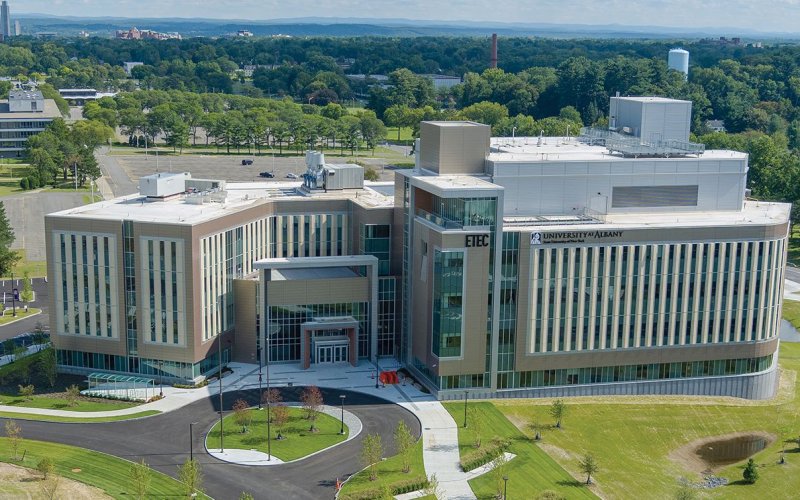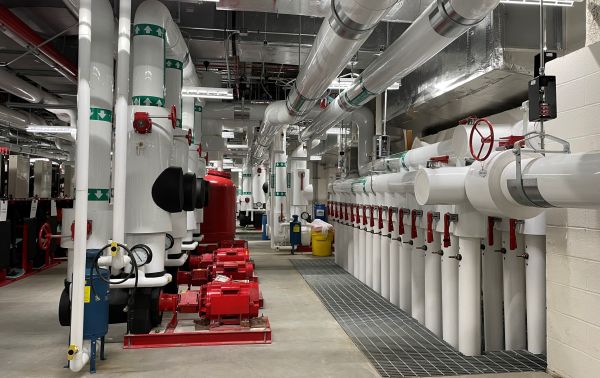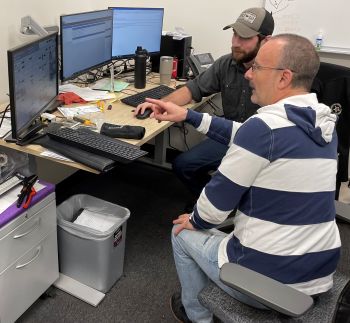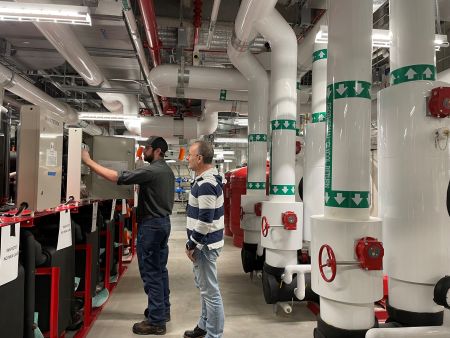Sustainable Design: ETEC Embodies UAlbany’s Commitment to Net-Zero Carbon Future

ALBANY, N.Y. (April 18, 2023) — UAlbany’s commitment to sustainability is embodied in its newest building, ETEC.

The 246,000-square-foot building, completed in 2021 and designed to achieve net-zero carbon emissions, achieved LEED Platinum certification, the highest level awarded by the U.S. Green Building Council for energy-efficient and sustainable buildings.
This month ETEC won a New York State Excelsior design award, which recognizes publicly funded projects for design excellence as well as overall performance and how the project impacts the user and the community. The architect, CannonDesign, the University, and SUNY/Construction Fund will be officially recognized in a ceremony on May 4.
Some of the features that make ETEC stand out — and helped the building achieve LEED platinum — include an energy efficient building envelope, LED lighting with occupancy and daylight controls, a geothermal heat pump system for heating, cooling and domestic hot water, demand-based lab ventilation, heat recovery ventilation and advanced controls. These systems combine to help ETEC save about 70 percent in energy costs and lower water usage by about 40 percent.

“ETEC is an all-electric building with no on-site fossil fuel combustion except for emergency use. All of the building's electricity is sourced from renewable energy systems, with half of its electricity from an on-campus nearly 2-megawatt solar photovoltaic system,” said Indu, UAlbany’s energy officer. “Green infrastructure practices such as porous asphalt parking and green roof that is integrated into academics and research, water efficient plumbing fixtures and landscape design, use of regional and recycled materials, and low-emitting finishes also helped with LEED Platinum certification.”
While the porous parking lot needs to be swept and vacuumed periodically to prevent the surface from being clogged with fine sediment, the green roof requires very minimal maintenance, said Brad Bunzey, project manager for architecture, engineering and construction.
“The vegetation chosen for the green roof is a mixture of perennials which require no maintenance and are tolerant to the conditions specific to the region," he said. "The only maintenance needed for the green roof will be a periodic removal of any weeds which may seed themselves.”
And because the geothermal system is a closed loop, it also requires little maintenance, according to Jacob Zaccagnino, a plant utilities engineer who’s in charge of keeping ETEC running. This primarily involves running routine checks and monitoring systems to make sure everything is running smoothly. The geothermal system circulates fluid through 190 wells under one of ETEC’s parking lots, utilizing the constant ground temperature to absorb heat in the winter months and discharge it back into the ground for cooling during the summer.

Because ETEC is a new construction, it was possible to incorporate energy-efficient components into the design of the building. Retrofitting existing buildings for efficiency is harder, but not impossible.
“As we renovate older buildings, we have been improving the building envelope, installing LED lighting with controls, and implementing various HVAC efficiency and controls,” Indu says. “One of the biggest challenges to beneficial electrification of older buildings is the migration of the heating system from high temperature hot water to low temperature hot water. Currently, most of our older buildings rely on a 200-400 degree Fahrenheit water to provide heating. We need to replace these systems to accept 110-160 degree heating hot water that can then be delivered from central geothermal heat recovery chillers.”
In any University office or laboratory, occupants can reduce energy use by purchasing Energy Star and EPEAT-certified equipment and appliances, and choosing more energy- and water-efficient options when purchasing lab and office equipment. This includes computers and printers, as well as specialized equipment such as ultra-low temperature freezers, refrigerators, dishwashers and autoclave. Setting up energy saving settings on equipment, such as sleep setting on computers, printers and copiers and shutting down equipment during breaks and intersessions also helps.
“Proper maintenance of equipment including defrosting and deicing freezers, cleaning and servicing coils, filters and motors allow lab equipment to operate at higher efficiency,” Indu said. “Turning up temperatures in ULT freezers or refrigerators, minimizing use of water aspirators, sharing lab equipment where appropriate, are some other ways occupants can help.”
Anyone interested in learning more about "greening" their labs or workspace can contact the Office of Sustainability for information and assistance.
“In order to achieve carbon neutrality, we need to reduce energy usage, replace all fossil-fuel heating systems with beneficial electrification systems such as geothermal heat pumps, source 100 percent of building's energy from renewable energy systems, implement advanced controls and data analytics for proactive building management, and ensure trained operators and educated occupants,” Indu said. “ETEC provides us with a template for these actions.”




